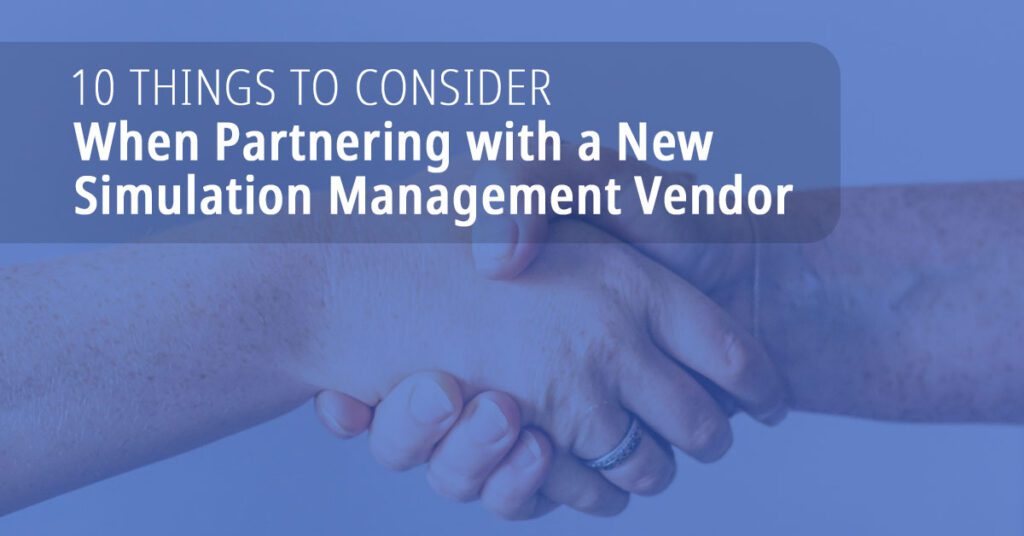Simulation training is a staple of modern healthcare education programs, enabling learners to practice and hone their skills in lifelike settings without the risk of harming patients.
These simulations don’t just bridge the gap between didactic and lecture-based learning though. Thanks to increasingly realistic simulation technology, learners can gain invaluable exposure to medical situations and scenarios they’re unlikely to encounter in clinicals. Today, this training can even be deployed outside formal labs, giving future care teams a taste of what it’s like to treat emergencies outside the hospital walls.
However, not all healthcare simulation tools provide the same cutting-edge experience. To achieve maximum results from your sim program, it’s imperative that partner with the right simulation management vendor.
So today we’re looking at the 10 things you should consider when selecting a new simulation management vendor.
1. Intuitive Interface and User Experience
An intuitive interface is essential for both instructors and students. A user-friendly design minimizes the learning curve, allowing users to focus on training rather than navigating complex systems. Look for vendors that prioritize usability, and verify that they offer dedicated support programs that extend beyond installation.
2. Active Software Updates
Regular software updates are vital for maintaining system performance and introducing new features. A vendor committed to continuous improvement will provide updates that enhance functionality, address bugs, and keep the system aligned with the latest medical and technological advancements.
Before making your selection, be sure your vendor has a strong track record of timely updates and transparent communication and seamless integration for new features.
3. Comprehensive Scheduling and Automation Tools
Effective scheduling and automation tools are crucial for managing the complexities of simulation training. These tools should allow you to schedule rooms, equipment, and instructor/participant sessions seamlessly.
Features such as automated paging and alerts, inventory management, and network monitoring capabilities help streamline your simulation activities and can ease the scheduling process, reduce administrative workload, and ensure that your organization’s resources are used efficiently.
4. Detailed Tracking and Reporting
Comprehensive tracking and reporting capabilities are essential for assessing the effectiveness of simulation training.
Look for systems that offer detailed reports on facility and equipment usage, customizable reporting features, and the ability to track learner performance over time. These tools can provide valuable insights into training outcomes and help identify areas for improvement.
5. Seamless Integration with Existing Systems
A simulation management system should integrate seamlessly with existing learning management systems (LMS) and other institutional software. This can lead to significant cost savings, operational efficiencies, and a smoother user experience.
Before making any decision, confirm that the vendor offers compatibility with your current systems and can support future integrations as needed.
6. Exceptional Video Capture and Debrief Capabilities
At the core of any simulation management platform is high-quality video capture capabilities. Effective debriefing tools are essential for maximizing the educational value of your simulations.
Look for systems that offer reliable video recording, easy-to-use debriefing tools, and features such as annotation and bookmarking to enhance the review process. These capabilities enable instructors and students to analyze performance and identify areas for improvement effectively.
7. Real-Time Communication Tools
Effective communication is key to successful simulation training. Real-time messaging and notification systems can help coordinate participants, inform them of upcoming sessions, and facilitate immediate feedback. Make sure the vendor offers robust communication tools that support both in-simulation and out-of-simulation interactions.
8. Scalability and Performance
As your training program grows, your simulation management system must be able to scale with it. Look for vendors that offer scalable solutions supporting increasing users and locations. Additionally, the system should maintain consistent performance during high-demand periods to ensure uninterrupted training.
9. Vendor Support and Training
Comprehensive support and training resources are critical for maximizing the value of your simulation management system. Choose a vendor that offers extensive training programs, responsive customer service, and ongoing support to address any issues that may arise. A dedicated support team can significantly enhance the user experience and ensure maximum return on investment on your chosen simulation management solution.
10. Cost Benefits
When evaluating a simulation management solution, it’s crucial to consider the cost benefits. Compare the initial investment against the projected long-term savings the system can offer through efficient resource management, reduced training time, and improved learner outcomes.
Maximize Your Healthcare Simulation Program ROI
Choosing the right simulation management vendor is a critical decision that can significantly impact the effectiveness of your healthcare training program.
By considering factors such as user experience, software updates, scheduling tools, tracking capabilities, system integration, video capture, communication tools, scalability, vendor support, and cost benefits, you can make an informed choice that meets your institution’s needs and delivers greater outcomes.
Curious how Education Management Solution’s simulation training solutions stack up? Schedule a call to find out how EMS can take your healthcare education program to the next level.

